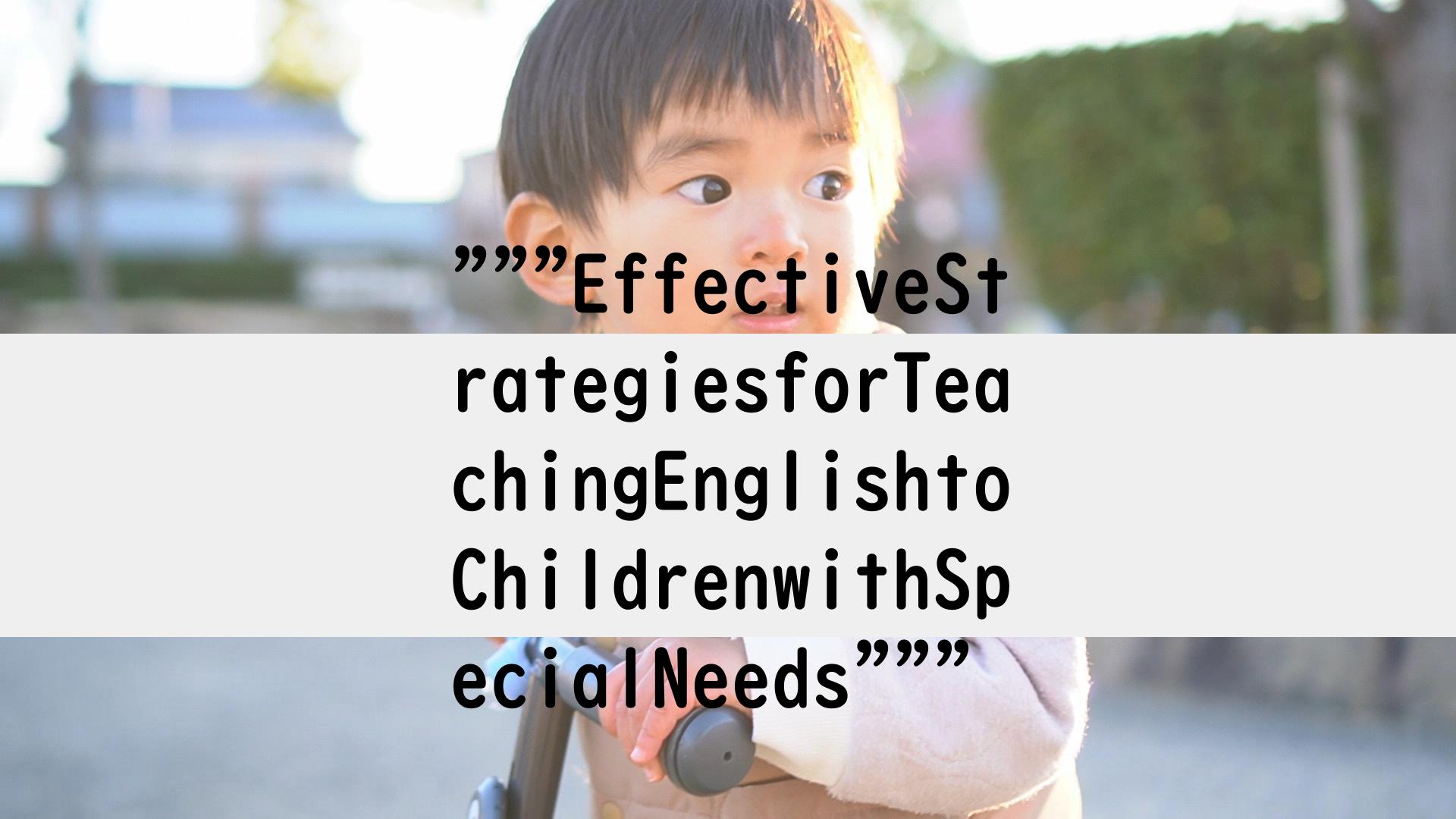- “Teaching English to Children with Autism: Strategies to Help Them Learn”
- “Supporting the Language Development of Children with ADHD through English Education”
- “Visual Aids and Storytelling Techniques for English Language Learning in Children with Asperger’s Syndrome”
- “Effective Communication Strategies for Teaching English to Children with Communication Disorders”
- “Incorporating Sensory Activities in English Lessons for Children with Sensory Processing Disorder”
“Teaching English to Children with Autism: Strategies to Help Them Learn”
“TeachingEnglishtoChildrenwithAutism:StrategiestoHelpThemLearn”Autismisaneurologicaldisorderthataffectsthesocialandcommunicativeskillsofanindividual.WhenitcomestoteachingEnglishtochildrenwithautism,itisimportanttounderstandthateachchildisuniqueandmayhavedifferentlearningstylesandabilities.However,therearecertainstrategiesthatcanhelpchildrenwithautismtolearnEnglishmoreeffectively.Herearesomeofthem:1.UseVisuals:Childrenwithautismtendtobevisuallearners,sousingpictures,videos,andothervisualaidscanhelpthemunderstandandremembernewvocabularyandgrammarrules.2.BreakDownInstructions:Whengivinginstructions,itisimportanttobreakthemdownintosmall,simplesteps.Forexample,insteadofsaying”writeaparagraphaboutyourfavoritebook,”youcansay”first,chooseyourfavoritebook.Next,thinkaboutwhyyoulikeit.Then,writeaparagraphaboutit.”3.ProvideRepetition:Repetitioniskeyforchildrenwithautism,asithelpsthemtorememberinformationmoreeasily.Practicenewvocabularyandgrammarrulesregularly,anduserepetitiongamestoreinforcelearning.4.UsePositiveReinforcement:Childrenwithautismrespondwelltopositivereinforcement,suchaspraise,rewards,andtokens.Usethesetoencouragegoodbehaviorandprogressinlearning.5.MakeLearningFun:Engagethechild’sinterestsandmakelearningfunbyincorporatinggames,songs,andotherinteractiveactivitiesintoEnglishlessons.6.BePatient:TeachingEnglishtochildrenwithautismcanbechallenging,butitisimportanttobepatientandunderstanding.Givethechildtimetoprocessinformationandencouragethemtoaskquestionsiftheydon’tunderstandsomething.Inconclusion,teachingEnglishtochildrenwithautismrequiresadifferentapproachthanteachingtypicallydevelopingchildren.Byusingthesestrategies,educatorsandparentscanhelpchildrenwithautismtolearnEnglishmoreeffectivelyandreachtheirfullpotential.
“Supporting the Language Development of Children with ADHD through English Education”
ADHD(注意欠陥多動性障害)の子供たちは、多くの場合、言語発達に問題を抱えています。
彼らは非常に敏感で、注意散漫であり、このため、言語を理解し、話すことができる能力に影響を与える可能性があります。英語教育は、注意欠陥多動性障害を持つ子供たちの言語発達を支援するための効果的な方法の1つです。英語教育は、子供たちが言語を学ぶための完全な環境を提供します。英語環境は、子供たちが言葉やフレーズを学び、発音や音声を練習するのに最適な場所です。英語教育は、子供たちに新しい言語を学ぶことに興味を持たせ、彼らの言語発達に役立つ認知能力を開発することができます。また、英語教育は、子供たちがコミュニケーション能力を向上させるのに役立ちます。彼らは、先生やクラスメートと英語でコミュニケーションを取り、新しい単語やフレーズを学ぶことができます。これにより、彼らは自信を持ってコミュニケーションを取ることができ、言語発達に必要なスキルを身につけることができます。英語教育には、子供たちが発音や音声を改善するための練習も含まれます。子供たちは、英語学習のプログラムを通じて、正確な発音やスピーキングスキルを習得できます。これにより、彼らはより明瞭に話し、コミュニケーションの障害を減らすことができます。最後に、英語教育は、言語発達に関する問題を抱える子供たちにとって、社会的スキルを向上させるのにも役立ちます。英語学習は、子供たちが自己表現や自己主張を行うスキルを身につけるのに役立ちます。これにより、彼らは自信を持って自分自身を表現することができ、社会的スキルを向上させることができます。英語教育は、注意欠陥多動性障害を持つ子供たちの言語発達にとって非常に重要な役割を果たしています。英語教育を通じて、彼らは言語スキルやコミュニケーション能力を向上させ、社会的スキルを身につけることができます。これにより、彼らはより多様な社会に適応することができ、将来的に成功することができます。
“Visual Aids and Storytelling Techniques for English Language Learning in Children with Asperger’s Syndrome”
「VisualAidsandStorytellingTechniquesforEnglishLanguageLearninginChildrenwithAsperger’sSyndrome」Asperger’sSyndromeisaneurodevelopmentaldisorderthataffectsaperson’sabilitytocommunicateandsocializeeffectively.ChildrenwithAsperger’sSyndromeoftenhavedifficultylearningnewlanguagesduetotheirimpairedcommunicationandsocialskills.However,visualaidsandstorytellingtechniquescanbeeffectivetoolstohelpchildrenwithAsperger’sSyndromelearnEnglish.VisualaidsareanexcellentwaytohelpchildrenwithAsperger’sSyndromeunderstandandremembernewwordsandconcepts.Flashcards,pictures,anddiagramscanbeusedtohelpchildrenmemorizenewvocabularyandunderstandsentencestructure.Visualaidscanalsobeusedtoteachaboutculturaldifferencesandhelpchildrenunderstandnewcustomsandtraditions.StorytellingisanothereffectivetechniqueforteachingEnglishtochildrenwithAsperger’sSyndrome.Storiescanhelptoimproveachild’slistening,comprehension,andspeakingskills.Storiescanalsobeusedtoteachgrammar,pronunciation,andvocabulary.WhentellingstoriestochildrenwithAsperger’sSyndrome,itisimportanttousesimpleandclearlanguageandtokeepthepaceslowandsteady.UsingvisualaidsandstorytellingtechniquestogethercanbeapowerfultoolforteachingEnglishtochildrenwithAsperger’sSyndrome.Forexample,ateachercanuseapicturetointroducenewvocabularyandthentellastoryusingthatvocabulary.ThistechniquecanhelpchildrenwithAsperger’sSyndromemakeconnectionsbetweenwordsandconceptsandimprovetheirabilitytounderstandandremembernewinformation.Inconclusion,visualaidsandstorytellingtechniquesareeffectivetoolsforteachingEnglishtochildrenwithAsperger’sSyndrome.Thesetechniquescanhelpchildrenimprovetheirlistening,comprehension,andspeakingskillsandmakelearningEnglishmoreenjoyableandengaging.Byusingthesetechniques,teachersandparentscanhelpchildrenwithAsperger’sSyndromeachievetheirfullpotentialandbecomesuccessfulEnglishlanguagelearners.
“Effective Communication Strategies for Teaching English to Children with Communication Disorders”
EffectiveCommunicationStrategiesforTeachingEnglishtoChildrenwithCommunicationDisordersTeachingEnglishtochildrenwithcommunicationdisorderscanbechallenging,butwiththerightcommunicationstrategies,itcanbedoneeffectively.HerearesomeeffectivecommunicationstrategiesthateducatorscanusetohelpchildrenwithcommunicationdisorderslearnEnglish.1.SimplifylanguageOneofthemosteffectivecommunicationstrategiesistosimplifylanguage.Childrenwithcommunicationdisordersmayfinditdifficulttounderstandcomplexsentencesorwords.Asaresult,educatorsshouldusesimpleandconciselanguagewhenteachingEnglish.2.UsevisualaidsVisualaidscanbeextremelyhelpfulforchildrenwithcommunicationdisorders.Pictures,drawings,andvisualcuescanhelpstudentsunderstandthemeaningofwordsandphrases.Forexample,showingapictureofacatwhilesayingtheword”cat”canhelpstudentsunderstandthemeaningoftheword.3.UserepetitionRepetitioniskeywhenteachingEnglishtochildrenwithcommunicationdisorders.Repeatingwordsandphrasescanhelpstudentsrememberthemandunderstandtheirmeanings.Educatorsshouldalsoprovidemultipleopportunitiesforstudentstopracticeusingnewvocabulary.4.Provideopportunitiesforhands-onlearningHands-onlearningcanbeeffectiveforchildrenwithcommunicationdisorders.Activitiesthatinvolvemanipulativesorotherhands-onmaterialscanhelpstudentsunderstandthemeaningofwordsandphrases.5.EncouragecommunicationEncouragingcommunicationcanhelpstudentsdeveloptheirlanguageskills.Teachersshouldprovideopportunitiesforstudentstocommunicatewitheachotherandwiththeteacher.Thiscanbedonethroughgroupdiscussions,role-playing,andotherinteractiveactivities.6.UsepositivereinforcementPositivereinforcementcanhelpencouragestudentswithcommunicationdisorderstoparticipateandcommunicate.Teachersshouldpraisestudentsfortheireffortsandaccomplishments,andprovidepositivefeedbackwhentheyusenewvocabularycorrectly.7.BepatientandunderstandingFinally,teachersshouldbepatientandunderstandingwhenworkingwithchildrenwithcommunicationdisorders.Learninganewlanguagecanbechallenging,anditmaytakelongerforthesestudentstodeveloptheirlanguageskills.Teachersshouldbepatientandprovidesupportandencouragementthroughoutthelearningprocess.Inconclusion,teachingEnglishtochildrenwithcommunicationdisordersrequireseffectivecommunicationstrategies.Bysimplifyinglanguage,usingvisualaids,providinghands-onlearningopportunities,andencouragingcommunication,educatorscanhelpthesestudentslearnEnglishanddeveloptheirlanguageskills.Additionally,providingpositivereinforcementandbeingpatientandunderstandingcanhelpcreateasupportivelearningenvironmentforthesestudents.
“Incorporating Sensory Activities in English Lessons for Children with Sensory Processing Disorder”
EnglishlessonscanbechallengingforchildrenwithSensoryProcessingDisorder(SPD),aconditionthataffectshowthebrainprocessessensoryinformation.ChildrenwithSPDmaystrugglewithprocessingandrespondingtosensoryinputs,suchastouch,sound,orlight.Thiscanimpacttheirabilitytofocus,learn,andparticipateinclassactivities.OnewaytohelpchildrenwithSPDcopewithEnglishlessonsistoincorporatesensoryactivitiesintothecurriculum.Sensoryactivitiesengagemultiplesensesandprovideahands-onlearningexperiencethatcanhelpthesechildrenbetterprocessandretaininformation.HerearesomeideasforincorporatingsensoryactivitiesinEnglishlessons:1.KinestheticLearning:Kinestheticlearninginvolvesusingphysicalactivitiestoteachconcepts.InEnglishlessons,thismayincludehavingstudentsactoutstoriesorplays,participateingamesthatinvolvemovement,oruseprops,likepuppetsorrole-playcostumes,tohelpthemengagewiththematerial.2.TactileActivities:Tactileactivitiesinvolvetouchingandfeelingobjectsormaterials.ForEnglishlessons,thiscouldincludehavingstudentstracelettersorwordsinsandorrice,createtexturedcollageswithdifferentmaterials,oruseclayorplaydoughtoformlettersorwords.3.VisualLearning:Visuallearninginvolvesusingimagesorvisualaidstoteachconcepts.InEnglishlessons,thiscouldincludeusingvideoclips,pictures,ordiagramstoillustrateconcepts,orhavingstudentscreatevisualaids,likeposters,tohelpthemrememberkeyvocabularyandgrammarrules.4.AuditoryLearning:Auditorylearninginvolvesusingsoundandmusictoteachconcepts.ForEnglishlessons,thiscouldincludehavingstudentslistentoaudiobooksorpodcasts,orusemusictohelpthemremembervocabularyorgrammarrules.IncorporatingsensoryactivitiesintoEnglishlessonscanhelpchildrenwithSPDbetterengagewiththematerialandimprovetheirlearningexperience.However,it’simportanttorememberthateachchildwithSPDisuniqueandmayresponddifferentlytotheseactivities.Teachersshouldworkcloselywithparentsandtherapiststodesignapersonalizedplanthatbestsuitseachchild’sneeds.



コメント